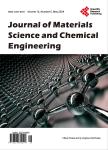The Impact of Clay Loading on the Relative Intercalation of Poly(Vinyl Alcohol)-Clay Composites
The Impact of Clay Loading on the Relative Intercalation of Poly(Vinyl Alcohol)-Clay Composites作者机构:Center for Advanced Materials Qatar University Doha Qatar Materials Science and Technology Master Program College of Arts and Science Qatar University Doha Qatar Gas Processing Center College of Engineering Qatar University Doha Qatar
出 版 物:《Journal of Materials Science and Chemical Engineering》 (材料科学与化学工程(英文))
年 卷 期:2016年第4卷第10期
页 面:20-31页
学科分类:08[工学] 0805[工学-材料科学与工程(可授工学、理学学位)] 080502[工学-材料学]
主 题:Poly(Vinyl Alcohol) Cloisite Nanocomposites Relative Intercalation FT-IR Spectra
摘 要:Polymer clay nanocomposites (PCN) materials are industrially applied because of their unique properties. However many of their physical and chemical properties have not been determined. The formed structures of polymer/clay nanocomposite depend on the nature of interactions between polymer chains and clay platelets. According to the possible modes of interactions between polymer matrix and clay sheets, these nanocomposites can be classified into: intercalated, flocculated and exfoliated nanocomposites. In this work, the morphology of the nanocomposite was studied using X-ray diffraction (XRD) and nanoscaning electron microscopy (NSEM). XRD and NSEM measurements confirmed the intercalation between poly(vinyl alcohol) chains and cloisite®20A sheets. Because of the intercalation between the clay platelets and the PVA chains, as the clay concentration increases as the band intensities in FT-IR spectra increase. On the other hand, the XRD did not provide clear shift of any of the clay peaks for PVA/cloisite® 10A nanocomposites and confirm the non-intercalation between PVA matrix and cloisite®10A platelets. The relative intercalation (RI) of PVA/Cloisite®20A nanocomposites declined with increase in the clay loadings. In contrast, for PVA/Cloisite®10A, RI values slightly increased with increasing the clay loading.



